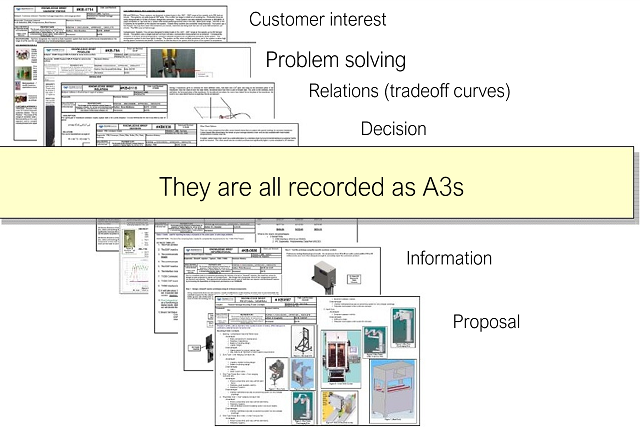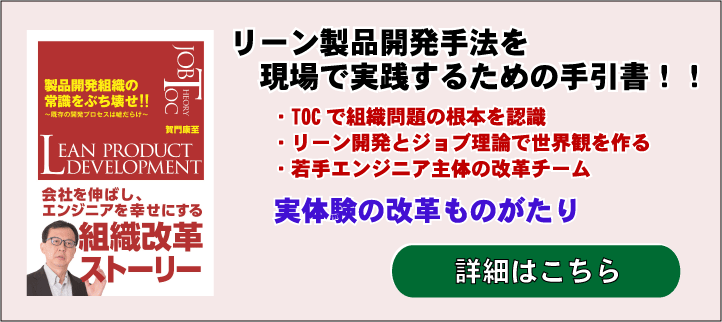

We started A3 reporting to make use of the company’s knowledge assets, but how do we reap the benefits?
After learning about Lean Product Development, I decided to implement A3 reporting as a first step. I gave my employees simple guidance and assigned them a quota for A3 reports, but even after a year, it did not lead to any results. They stopped at how to write the reports and want to know how to get the results they need.
Just learning Lean Product Development, starting an A3 report activity, and having employees write A3 reports will not produce any results. An A3 report that is left unwritten will not be read and will not be useful. In order for the report to be useful for the company organization, the content must be something that the reader wants to read, and it must be useful for the reader’s business. We will show you how to systematically improve the level of your A3 report.
Specifically, you need to create the ability and system for mutual introduction among supervisors and team members to improve the quality of the A3 report to a level where it can be reused within the organization.
Contents of this article
The purpose of introducing A3 reports

Lean product development consists of three key elements: chief engineer system, set-based development, and the A3 report
(reference :What is Toyota Lean Product Development?)
The purpose of learning the Lean product development method and implementing it in our company varies, but I think the main purpose is to review the company’s “knowledge assets,” develop a development process and organizational capabilities that effectively generate “knowledge assets,” and change the organization to one that develops products while learning, so that we can efficiently produce good products.
In this context, many companies have decided to start with A3 activities because the results are relatively easy to see, and the purpose of introducing A3 reports is essentially to take a firm inventory of “knowledge assets” in the organization and leave them as something tangible.
In the hurdle activity of changing the development process that has been established in the company for a long time, I think that in some cases it is easy to think that the first step is to quickly achieve visible results with the team, but I have repeatedly said that It means that if you try to adopt only the form, you will fail!
Some companies set a goal for the number of A3 reports to be produced from the beginning.
If you set only the number of pages as a goal without focusing on how the organization will ”change” through the A3 report activity, it will never work out.
The wrong pattern is to start by getting into the habit of writing A3 reports, then set a quota for writing them, and when the number of reports is accumulated, link them to a document management system so that they can be searched and used within the company.
The reason why this does not work is that each A3 report is not written in a way that is readable and useful within the company.
Once again, going back to the essence of the A3 activity, it’s not a matter of
To improve the efficiency of development activities by covering and sharing internal knowledge assets.
I think you should set a specific objective (what, by when, and how much) and set a specific numerical target to achieve it.
There is a rule called”10/10/10” in the A3 report.
- 10 hours to write
- 10 minutes to read
- 10 seconds to reuse
It’s a metaphorical expression, but writing is hard work. If you’re not used to it, you might not be able to write for even 10 hours.
Ten minutes to read means that you don’t have to give a long verbal explanation at a meeting, etc., if it is visually easy to read and utilizes images, tables, etc., as well as text, so that it can be easily understood by others. A report that is written in a way that can be easily understood is a report that can be read and utilized.
And lastly, 10 seconds to reuse, which means that a good report is memorable.
A good A3 report used in a debriefing or a meeting will be remembered by people, and when a problem arises, they will say, “Oh, I remember that time.
A good A3 report that is used in a debriefing or meeting will be remembered by people, and when something goes wrong, they will say, “Oh, that guy wrote a report like this.”
This means that the report can be easily reused, including by word of mouth.
I am not denying that IT can improve business efficiency, but I sincerely hope that you will first make each A3 report something that readers want to read, and then make it an activity that achieves the original essential purpose.
Turn the report into a reader-driven report, not a writer’s one.

In the Toyota method of lean product development, the A3 report is a tool used to create knowledge assets, to trigger innovation through knowledge assets, and to efficiently promote product development by accumulating and reusing knowledge assets within the organization.
Knowledge assets play the role of “blood” in a development organization, and the circulation of blood activates development activities and provides energy for the organization to grow.
By writing down the “knowledge assets” in an A3 report, distributing and managing them, the product development process is stabilized.
In lean product development, the A3 report may be like a blood vessel that circulates blood or a blood circulation system that runs through the body.
Considering such an important role, the quality of the A3 report cannot be easily blamed on the author alone.
If the role of the report is to be a medium for communicating the company’s “knowledge assets,” then the quality of the A3 report must be guaranteed by the organization.
What kind of quality is required is a quality that can withstand being read and used by the members of the organization.
However, the reality in many companies is that the author is responsible for writing the report and writes what he or she wants to write.
Of course, the author has a certain amount of responsibility, but I don’t think management can escape its responsibility if they let useless reports go unchecked in the company.
I suppose it is possible in reality to have a report that is commissioned by the boss and only needs to be reported to the boss, but considering the time required to create a work of art called a report, it is essentially useless to have a report for one person.
I believe that a report should be useful not only for the present, but also for the future, and sometimes for a wider audience than the author expected.
In order for an A3 report to be widely used in the future, it must be reader-driven, understand what the reader is looking for, and be written in a way that communicates well what the reader is looking for.
When introducing A3 reports, the first thing that must be done is to change the culture of report writing to one that is reader-driven rather than writer-driven.
Actually, this may be quite a hurdle.
It is necessary to make a cultural change to think of so-called internal people as customers, that is, to create an internal marketing mindset, as well as to create the skills to write good reports or the leadership and instruction system to make them write good reports.。
The quality of an A3 report may be similar to web marketing.
Even in the web world, if a website or blog post is not useful, it will not be read by readers.
It is said that Google’s search engine is evolving day by day, and only pages that are useful to readers are made to be at the top of the search results.
That’s why companies and people who are implementing web marketing try to gain access to their pages by making pages that are really useful.
I think that A3 reports in companies should also be given some incentive to be read and used, so that the writers are highly motivated to produce reports that are useful to the company.
Before writing, make a proposal for an A3 report

In order to create a report that will be understood by the reader and useful to the company, I recommend that you first develop a plan before you start writing.
This can be as simple as creating a proposal for the report.
This is not necessary if the organization as a whole has improved its level of A3 reporting, but please try it after the introduction of A3 reporting activities and until it is established as a system.
Before you start writing your report, make sure you have
- Title of the report
- Who and what the report is intended to communicate
- What is the significance of the report to the company?
- What kind of story will you tell?
Then discuss it with your team, including your supervisor.
The team, including your supervisor, will discuss the report and rewrite it as many times as necessary until you are satisfied.
Title of the report
The title of the report clearly indicates the author’s intent.
The title shows whether the report is valuable as a “knowledge asset” of the company and whether the author intended it to be meaningful.
It is also very important that the report is one that the reader will want to read when it is actually published.
If there is nothing in the title that appeals to the reader, the report will not be read in the end.
The most common titles are limited words such as “on xxx projects” or “on xxx products.
This may be necessary, but information that can only be used in a limited area will be useless to people in other areas.
It is very important for each individual to think that even if the work they have done is for some special project, they want to make the knowledge gained widely available.
When writing a report, if it can be written in such a way that it can be used even if it is not for a special project, the project name, etc. may disappear from the title, and even if the project name remains, the title will give the impression that it is helpful to the reader.
The idea of using the acquired knowledge within the company actually affects the mindset towards work.
When you do experiments or simulations to acquire knowledge, you will not take the range of variables that are applicable only to the project you are in charge of, but you will start doing experiments and simulations that take the future or other projects into consideration.
Aim for the title to include a feeling of knowledge utilization.
Who and what is the report intended to communicate?
To put it simply, the purpose of the report is to clarify “who” the report is written for, “who” is considered to be the customer, and “what” the report is trying to contribute by communicating to the customer, so that the “knowledge assets” of the company can be strongly recognized.
The customer is not one specific person, but a broad, generalized target, and the report should be written with both current and potential customers in mind
As for what to communicate, take into consideration what problems the target customers are suffering from or will suffer from in the future, and contribute to them by solving their problems and troubles.
Conversely, if it cannot contribute to the customer’s problems and troubles, it is not worth reading.
In my experience, immediately after the introduction of the A3 report, many people are troubled about what to leave as an A3 report.
In many cases, the result of worrying about this is a report that is not very appealing to the reader, and I would like the team to carefully examine this first before starting to write.
What significance does the communication have for the company?
It is very important for the author to be aware of the significance to the company of the result of communicating what to whom.
When everyone is aware of the company’s “knowledge assets,” it not only improves individual productivity, but also greatly enhances organizational capabilities.
I also encourage people to get into the habit of viewing their significance to the company as the greatest possible outcome.
For example, if the direct significance of your report is to prevent people from stumbling over the same thing, you can prevent people from wasting time by stumbling over the same thing, and shorten the schedule of the entire project.
Furthermore, you can think about how the elimination of schedule delays will reduce sales opportunity losses and improve sales, or reduce development costs and increase profits.
Rather than exaggerating your accomplishments, you will be motivated by the awareness that your work is that important.
What story to tell?
Once you have agreed with your manager or team on the title, purpose, and significance to the company of the report, the last step is to think about the story you want to tell the reader.
This is the most important part of the quality of the report.
It can be described as a “beginning, middle, and end” story, but it is important to make sure that the story is logical and does not contain any assumptions made by the author or the organization, and more importantly, that it is written in a way that can be easily understood by internal readers.
I think the following are some of the most common reasons for bad reports.
- Written to default results
- Does not grasp the essence of the problem (does not grasp the important issues)
- Does not capture the current situation objectively and accurately
- Many ambiguous expressions (difficult, large, etc.)
- Too much content unrelated to the conclusion or main argument (too much extraneous information)
- There are leaps in logic (it is unclear why this is the case)
- There are many descriptions that only the person in charge can understand
- Many descriptions that only the person in charge can understand
※ This is also a check list for report review.
Such as. (There are still others.)
As explained in the 10/10/10 rule, an A3 report should be quick to read and convey the author’s true intentions in a short time.
If it doesn’t connect logically, a question mark (?) will appear the moment you see it. mark will come to mind and you will feel uncomfortable.
Some people say that stories are “data with a soul.
Writing an article, presentation or report as a story doubles its persuasiveness.
I believe that having the story firmly in the author’s mind in the first place leads to trust and empathy for the author.
I would like to aim for management that will enable many people in the organization to do storytelling.
How to create an instruction system that achieves results

Achieving results through the implementation of the A3 report is to achieve the essential purpose as mentioned in the beginning.
Let’s assume for a moment that the effective use of “knowledge assets” through the A3 report activity reduces the time required to resolve quality issues, resulting in zero schedule delays.
In order to shorten the time to solve quality problems by sharing “knowledge assets” within the organization, it is necessary to create a situation where “knowledge assets” such as past failure cases and how to deal with difficult problems are shared and utilized within the organization by creating A3 reports on a priority basis.
It may be necessary to incorporate into the development process the question of whether the database of A3 reports on past problem countermeasures is checked during design reviews.
In this way, we need to ensure the quality and quantity of the necessary A3 reports to ensure that the measures are taken to achieve the set goals and objectives and that the measures work smoothly.
Leadership to guide this is needed first.
I will not dare to discuss the setting and management of the measures here. This is something that can be done in the course of normal management.
I believe that it is not so difficult to determine what should be in a report for the purpose of shortening the time to solve quality problems and eliminating projects that are behind schedule, if management does an honest inventory.
The question is, then, to what level of quality does each A3 report need to be raised?
The level of quality of the A3 reporters is directly related to the organizational capability, which is something that many companies struggle with right after the introduction.
Even if you can somehow say, “This is not good enough,” I think there will be a difference in the speed of achieving results after the introduction depending on how many people there are in the organization who understand how to improve the situation and can provide practical guidance on how to write reports.
Or, if an instruction system is not created, it may be impossible to achieve results forever.
There are two approaches to help organization members to be able to write quality A3 reports.
There are two approaches that can help organization members to write quality A3 reports.
- Look at a lot of exemplary A3 reports
- Work hard with your manager and team to produce several A3 reports that you are comfortable with
In either approach, the key is actually the manager level people.
If both managers and employees start A3 report activities at the same time, managers who are not able to do so may not be able to set an example for their subordinates, may not be able to guide their subordinates, and may become reluctant to do the A3 report activities themselves because they are not able to do so.
What we would like to recommend is that first of all, management-level people should be trained to the level where they can write A3 reports of a certain quality, or where they can firmly instruct their subordinates.
If a manager is unable to provide guidance but is told by the top management to proceed with the A3 report, it is easy to fall into the situation of leaving it to the field (Genba).
If a manager says, “I don’t care about the guidance, but make sure the field (Genba) is doing well,” he or she is unlikely to succeed.
As a way to proceed with the reform, I think it is important for the manager class to first master the essence of the A3 report, be certified as a leader, and establish a leadership system.
As for the training method, as explained in the section on “What kind of story to tell,” a sure way to master the A3 report is to refer to examples of bad reports and learn the checkpoints in a logical way, while actually writing the A3 report and rewriting it many times until you are satisfied with it and the people around you are also convinced.
This is a form of mutual learning.
When actually leading subordinates and juniors as a supervisor, you should not be the only one leading them, but work as a team and receive advice from others, so that the quality of your work can be improved through your own awareness.
The teaching method is not to give answers, but to give hints and make people aware.
reference book:
Easy to understand case study of communication between supervisor and subordinate to complete an A3 report
Related Articles:
Product Development Innovation through A3 Reporting Culture
A case study of organizational reform through improved report writing
In the case of the introduction of the A3 report that we support, we are in charge of the facilitation of the A3 report review meeting, and we provide advice and guidance to the authors to improve the quality of the report. We also provide advice and guidance to authors to improve quality. We will teach you how to promote mutual learning at the field level.
We can give you a trial report or two and give you advice on how to improve them.
If you are interested in implementing the A3 reporting activity, please let us know.



